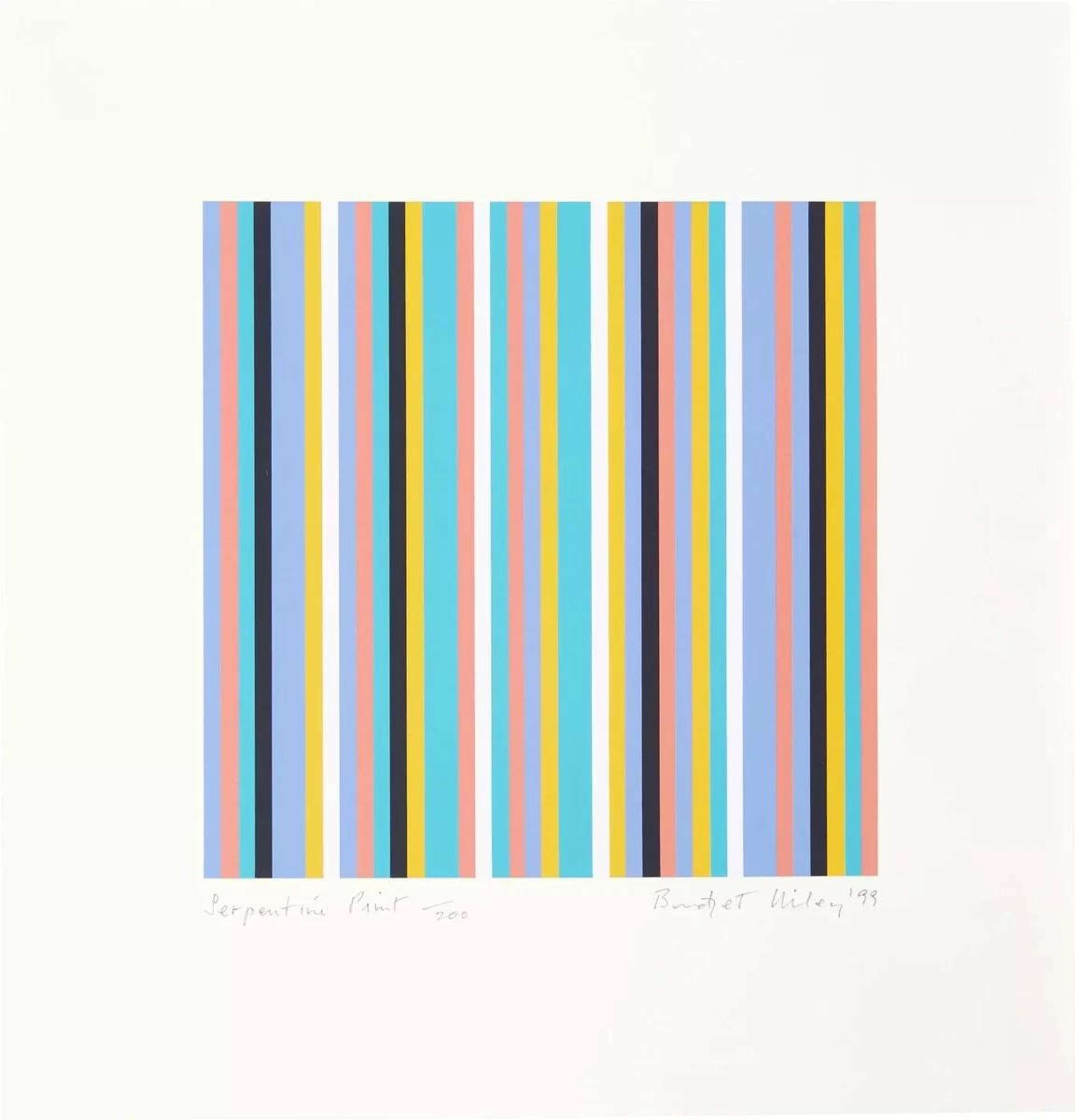 image © Christie's / Fete © Bridget Riley 1998-2002
image © Christie's / Fete © Bridget Riley 1998-2002
Bridget Riley
111 works
Bridget Riley exhibitions span throughout her career from 1964 to 2021. Queen of the optical illusion and beloved staple of British art, Riley is one of the most important names in Abstraction and is known for her pioneering role in the creation of Op-Art in the 1960s. Through the manipulation of geometric forms, using everything from concentric circles to simple parallel lines, Riley’s work transcends the canvas and toys with our visual perception.
Internationally recognised and immediately impactful, her works go further than the canvas that contains them: they force us to question the very act of looking itself, to ask whether we can really trust our own eyes, and what greater meaning lies behind apparently simplistic marks on a page. In the words of Hayward curator Dr. Cliff Lauson, ‘Perception itself is the medium she is working through.’
Here we take a look at some of Bridget Riley’s most famous work through exhibitions that have defined her career.
The Responsive Eye, MoMA, New York, 1964.
The exhibition that catapulted Bridget Riley to rapid fame, The Responsive Eye was held at New York’s MoMA in 1964. She was featured alongside the already renowned ‘Grand-father’ of Op-Art, Victor Vasareley and her emblematic Currents (1964) was used as the exhibition catalogue cover.
A huge hit with the public, tickets for Riley’s solo show that same year at the Richard Feigen gallery sold out the day they went on sale. Her work was described as inciting everything from ‘seasickness’ to ‘sky-diving’. Riley’s monochrome works, such as her Fragment series, became an international sensation almost overnight, despite critical reception at the time being largely negative - reducing her paintings to simply ‘tricks of the eye.’
 Image © MoMA / Currents © Bridget Riley 1964
Image © MoMA / Currents © Bridget Riley 1964Venice Biennale, 1968.
Now dipping her toes into new levels of optical phenomena, Bridget Riley presented her first exploration in colour, the seminal Chant 2, at the 1968 Venice Biennale. Breaking away from a rigorous devotion to monochrome images, this red and blue piece marked a real shift in her body of work, set the stage for her Stripes, and cemented her name within the sphere of 20th century art. Here, as a result, Riley was not only the first woman, but the first British Contemporary Painter to be awarded the International Prize for Painting.
 image © Christies / Chant 2 © Bridget Riley 1967
image © Christies / Chant 2 © Bridget Riley 1967Bridget Riley: Paintings from the 60s and 70s, Serpentine Gallery, London, 1999.
Following Riley’s explosive entrance and success in the art world over the previous decade, Op-Art had found its way into public consciousness, and was becoming immediately absorbed into the spirit of the swingin’ 60s. It is no surprise then, that following the Responsive Eye and Biennale, Riley’s work was snapped up by fashion designers and commercial industries all over the world - albeit to the artist’s dismay. She felt that exploitation of her prints and creations, especially at a time where there was no artist’s copyright, cheapened her practice. This discomfort coupled with the rise in popularity of the less visually-disciplined Neo-Expressionist movement in the 1980s, saw Riley’s practice slip from the limelight.
This was of course until the Serpentine’s seminal ‘Bridget Riley Reconnaissance,’ in 1999 - An exhibition of her key works from the 1960s-1970s that reignited the Op-Art flame. Containing 33 works by Riley from her early career, as well as new ones made specifically for the show, such as Serpentine Screenprint, their impact on the development of British painting was made glaringly apparent in the context of the YBA rise happening at the time - ahem Damien Hirst - and her practice was once again propelled to popularity, this time here to stay.
 image © Sotheby's / Serpentine Screen Print © Bridget Riley 1999
image © Sotheby's / Serpentine Screen Print © Bridget Riley 1999Learning from Seurat, The Courtauld Institute, London, 2016.
A smaller, but by no means less important exhibition of Riley’s work, this 2016 show at the Courtauld offered a look at her practice through a different lens. Famed pointillist artist George Seurat has always been a source of inspiration for Riley, whose mature practice draws from the lessons of colour demonstrated by pointillism. This show exhibited Riley paintings alongside Seurat’s to illustrate their comparative elements, dizzying in terms of positive public reception as well as quite literally when looking at these paintings.
 Image © Hayward Gallery / Copy after Le Pont de Courbevoie © Bridget Riley 1959
Image © Hayward Gallery / Copy after Le Pont de Courbevoie © Bridget Riley 1959The Hayward Retrospective, London, 2019.
One of the most celebrated exhibitions of Bridget Riley’s work, The Hayward Gallery, working with the artist herself and the National Galleries of Scotland, produced the largest Riley retrospective seen to date. A comprehensive look at her most famous works and their origins, previously unseen sketches and her only three-dimensional work, the monumental Continuum, this exhibition was a huge success. The sense of timelessness, of the eternal, so inherent to Riley’s practice clearly lends itself well to viewers in any context - ensuring they maintain their pull even when they are no longer necessarily ‘new.’
Pleasures of Sight, The Lightbox Gallery, Surrey, 2021.
To mark Riley’s 90th birthday, a retrospective exhibition, containing six-decades of her output, was only fitting. Seeing her works in this context allowed the public to see the continual celebration and development of optical potential in Riley’s career. The artist has played with form, colour and movement in a way totally unlike anyone else. It is a love of sight and of how our own perception can surprise us that characterises her work.








